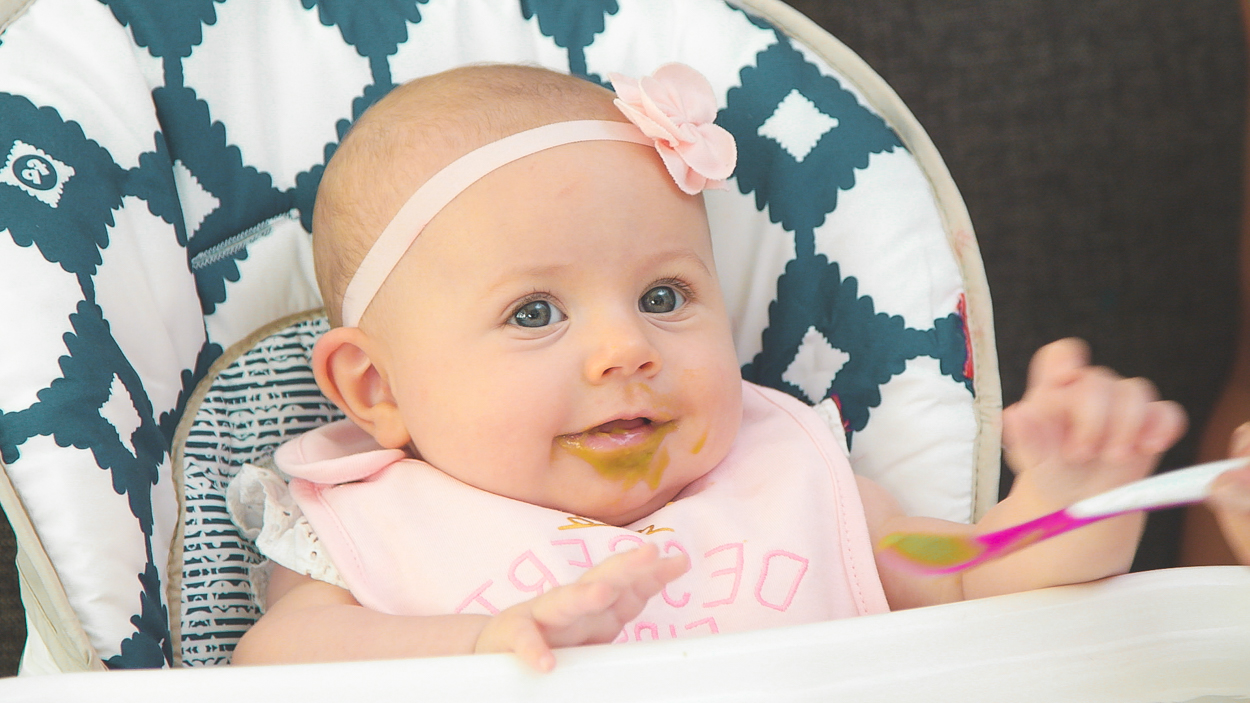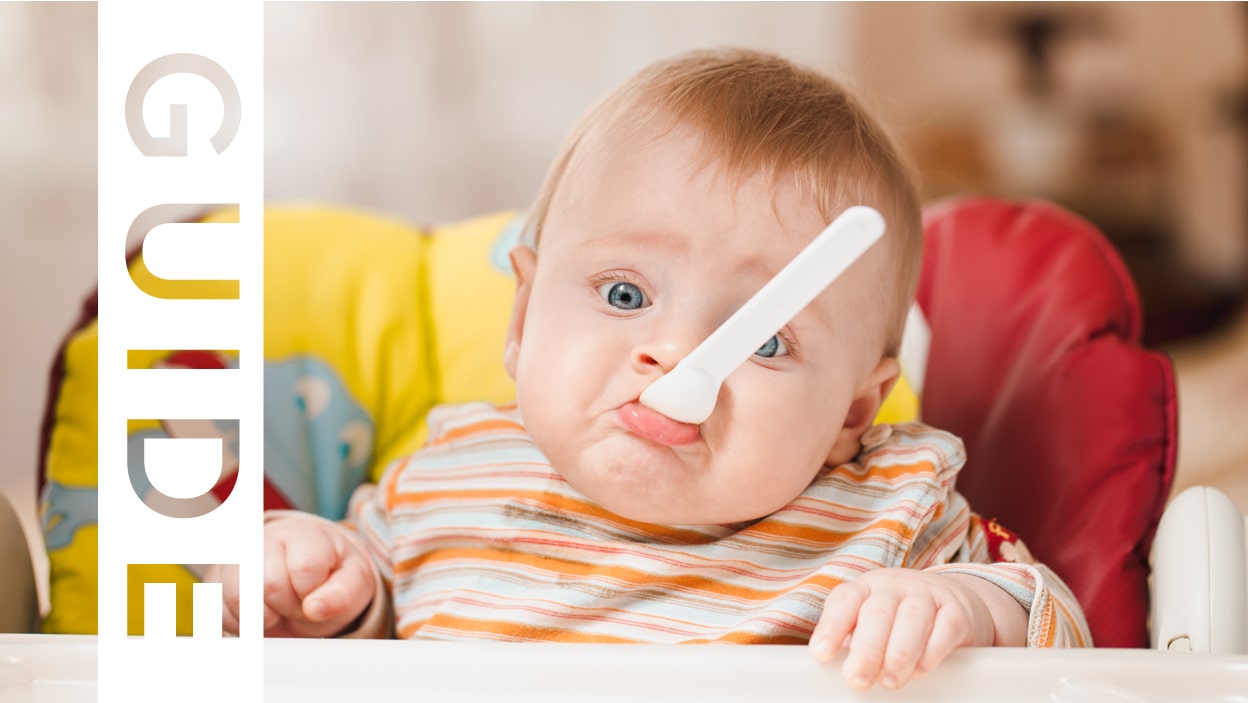

The first time my husband and I left our baby with my mother-in-law for a weekend, I drew up a VERY CRAZY list of instructions for her. My husband was quick to (kindly) remind me that she’d raised two kids of her own, which was more experience than I had. Truth.
OK, so I definitely had some nervous new mom stuff going on. But, more than that, I just knew that parenting norms and practices have changed so much over time, and I wanted to loop in my MIL to the way we were doing things. As I saw it, who wouldn’t be slightly disoriented by the new landscape? I even had to get used to some newnesses between my first and second kids, born 5 years apart.
We’re onto wiser and safer standards than ever before. Here are just a few of the parenting norms that are a look quite different than they did when I was a babe:
1) Starting Solids
What we’re taught to feed and not feed our babies — and when to do it — has been evolving, and at this very moment we’re privy to so much illuminating science, especially in the areas of allergy and immunology.
Take peanuts, for example. Pediatricians used to tell parents to wait a year before introducing peanut butter and any other highly allergenic foods (fish, egg whites, etc), and to wait even longer if there’s a family history of allergies. Now we know that the exact opposite is true; early introduction of peanut products can actually help reduce the likelihood of peanut allergies, and, in turn, reduce the number of fatalities from anaphylaxis.
“This is a great example of evidence-based medicine at its finest,” said Dr. Karen Hovav, a Los Angeles-based pediatrician. “Turns out things that sounded like a good idea just made things worse. Once we were able to do studies on thousands of children, we were able to establish best practices based on what actually works.”
Now guidelines say that instead of waiting until 1 year, parents should introduce peanut butter and other allergenic foods at 6 months. If there’s a family history of allergy, it’s often actually recommended to introduce even earlier, in the 4-6 month window. (Want to get started on peanut exposure? Try this.)
Similarly, parents used to give rice cereal as baby’s first food since it’s very unlikely to cause allergies, but now docs suggest more varied foods earlier, like pureed meats — to help prevent iron-deficiency anemia which is more common in breastfed infants — along with veggies, fruits, beans and just generally a wider array of food.

Dr. Hovav also encourages parents to introduce spices early. “We recommend avoiding salt, but it’s great to get babies used to diverse spices like cinnamon, garlic, rosemary, oregano and thyme,” she said. Fun fact: if your baby is breastfeeding, s/he is already getting all kinds of tastes via your diet. That is to say, if you ate Indian last night, so did baby.
And will introducing babies to a wider variety of textures and flavors early on make them better feeders later? Hovav thinks so.
“There are several studies that indicate that this may truly be the case, and even if we start off with purees, earlier transition to regular table food probably helps children down the road.”
2) Driving/car safety
When I was little, no part of the car was off-limits; if there was space and your body fit in that space, you could ride there. I rode in the way-back (the most fun), in the front seat (the most grown-up) and squished between friends on the armrest (the coziest) depending on the day.
Nowadays, thankfully, it’s a whole new car safety world. Babies graduate from the infant car seat to the convertible car seat (backwards-facing at first), then much later to a booster seat, which they’re required to use until college. Just kidding about the college part. Kind of. The recommendation is to use a booster seat until a child is 4’9″ and 8 – 12 years old.
This may seem like overkill, but according to Hovav, evolving guidelines like this have helped decrease the rates of child fatalities in car crashes 50% between 1975 and 2016.

3) Baby Proofing
OK, when I was a kid I don’t think this was even a thing. At least not in my house, where a person had to roam at their own peril. We had gates at the stairs, a playpen (baby jail) that my brother and I lolled around in a lot, and some plug covers, but that may have been the extent of it. Certainly nothing was affixed to anything. No latches were added to cabinets. Water temperature gauge? Toilet locks? Table-corner bumpers? Definitely not.
These days, baby proofing is a whole industry. Companies will come into your home and whip it into shape; when you’re traveling, you can even choose a hotel with baby- and child-proofed rooms. Sure, all this can slide into over-the-top territory; it’s all too easy to prey on parents’ fears. But safe is good – and there’s a happy medium.
Hovav said that at a minimum, parents should remove hanging cords, install locks on most drawers and cabinets (especially those containing cleansers, medications, or anything toxic), cover table corners, and, if there’s a pool, make sure it has a locked gate. Also, block off stairs and anchor shelves and dressers to the wall. That’s a solid start.
4) Sleeping
Back in the day, our parents were instructed to put babies on their tummies to sleep in order to prevent the possibility of choking on spit up. Now it’s known that it’s safest to place babies on their backs. The Back to Sleep campaign from 1994 (now called Safe to Sleep) has helped reduce the incidence of SIDS (Sudden Infant Death Syndrome) by a whopping 50%.
Said Hovav, “It’s not entirely understood why SIDS happens, but we do know that it’s much less likely when a baby sleeps on his/her back.”
And remember drop-side cribs (how else were you supposed to get a sleeping baby in?!)? Done and done, for the hazards they posed re: entrapment. And bu–bye to cushy crib bumpers and cozy bedding, too. Current guidelines say that until age one, babies are to sleep on a flat surface free of pillows and any other soft bedding.
5) Breastfeeding
Breastfeeding has seen its ups and downs since my baby days (after a decline in the 1980s, it saw a resurgence in the mid 1990s) but in 1998, the American Academy of Pediatrics (AAP) revised its policy and recommended that infants be exclusively breastfed for 6 months and ideally continue nursing until 1 year. “Breast is best” is ubiquitous and accepted now, and 70% of moms try breastfeeding — an all-time high since these stats began being recorded in 1955.
Hovav points out that while many of us grew up on formula and turned out perfectly fine, we’re continuing to learn about the many health benefits of breastmilk: it can help reduce the incidence of obesity, diabetes, ear infections, upper respiratory infections, and allergies – just to name a few. So now it’s less about asking is breastfeeding the healthiest choice? and more about focusing on ways to help women continue breastfeeding: better lactation support, better breastfeeding-friendly policies in the workforce, and better education about how hard breastfeeding can be in the beginning.
“I do feel the pendulum has swung a bit and now there’s a sense that because breast is best, formula is evil, and a lot of moms have guilt if they don’t make enough milk or if breastfeeding doesn’t work out,” said Hovav. “So while breastmilk is definitely the ideal form of nutrition for a baby, I do believe that ultimately ‘fed is best’.”







